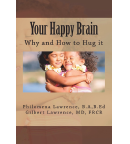BOOKMARK
Title: Your Happy Brain: Why and How to Hug It
Authors: Philomena Lawrence, BA, BEd, and Gilbert Lawrence, MD, FRCR
Publisher: CreateSpace Independent Publishing Platform
Publication date: June 2018
Price: $16.00, paperback, 390 pages

Some 2,400 years ago, the ancient Greeks were among the first people on earth to investigate the link between our physical body and our emotional responses. Their hypothesis of emotional well-being rested on harmony of the four humors: yellow bile, black bile, blood, and phlegm.
After the Greeks were proved wrong, centuries of brain studies gave us incredible insight into the most complex thing in the universe: the human brain. Current neuroscience strongly suggests that happiness, like all other emotional experiences, is generated by electrochemical stimuli in the brain. This intriguing subject is the basis for a new book by Philomena Lawrence, BA, BEd, and Gilbert Lawrence, MD, FRCR, called Your Happy Brain: Why and How to Hug It.
Getting to the Source of Mental Illness
According to the authors, the purpose of their book is to introduce readers to the most recent studies examining the workings of the brain and how it affects behavior. The information in the book is drawn from personal and work experiences (Dr. Lawrence is a radiation oncologist) as well as from voluminous books and presentations.
Current neuroscience strongly suggests that happiness, like all other emotional experiences, is generated by electrochemical stimuli in the brain.—
Tweet this quote
The authors sum up the meat of their work: “In practical terms, this work presents a broad overview of the causes of certain mental health issues, as well as constructive methods for alleviating or possibly preventing them.” As they point out in the opening chapter, about 45% of Americans will suffer from some form of mental illness during their lives—a huge and growing problem exacerbated by the opioid overdose crisis.
Mental health is a tough subject. For one, books on the subject abound, from heavy clinical tomes to overbearing tough-love treatments. To their credit, the Lawrences took a different approach than the majority in this genre—they focused on the inner workings of the brain and used a naturalistic approach to explain psychological issues, offering the reader a narrative that deftly speaks to the professional as well as the lay person.
The Brain’s Inner Story
In chapter 2, “Reach Out and Touch Someone,” the authors do a nice job revisiting the subject of close human contact. It’s a topic that needs more coverage, especially in this new digital age, which can mesmerize many people into asocial introverts. To their credit, the authors return to this theme in appropriate sections throughout the book.
Given that most lay readers do not have a working knowledge of the brain and many health professionals may have forgotten much from their neuro-anatomy courses, the authors carefully dissect the brain and use anecdotes and analogy to explain the interconnected functions. For instance, the pentagon serves as an analogy for the brain’s outer and inner workings.
“Each wing of the Defense Department has its own sections in charge of various functions. The main hubs of that department are like the brain components, and the subsections are similar to the groups of nuclei…. Each individual working in the Pentagon is like a neuron with its own inflow and outflow of information, via dendrites and axons, respectively.” It might seem overly simplistic to the devoted science reader, but these analogies work, and the authors use them judiciously.
Insular Dysfunction
Although the brain is the lead character in Your Happy Brain, as the book winds toward the later chapters, it delves into areas of “insular dysfunction,” which is purported to cause stress, dementia, and addiction. The section about dementia and the limbic system could have been fleshed out a bit more, as dementia was long associated with the cerebral cortex until later work showed the direct involvement of components of the limbic system, arguably the most interesting part of the brain. However, this is a small gripe in an otherwise excellent section.
Addressing Social Disorders
The authors even foray into thorny issues such as high-school dropouts and divorce in a chapter titled “Social Issues May Be Disorders.” Here, the authors explore both social and neurologic factors that contribute to failure in school and marriage. It’s a tricky balance of science and sociology, but for the most part, it offers sound, evidence-based arguments and resolutions. One of the more thought-provoking lines of inquiry is the role of the insula, which has increasingly become the focus of attention for its role in body representation and subjective emotional experience.
Your Happy Brain is a dense book, each page jammed with information and insight, most of it valuable and well-conceived. The book focuses on the factors that influence brain growth and human development. It is also chock-full of sound advice; it is never preachy but firm in its conviction. And although these subjects have been written about voluminously, the authors of Your Happy Brain do it their way. And there are comparatively new concepts, such as the intricate discussions on the role of the insula, which are fascinating. This book is recommended for readers of The ASCO Post. ■

